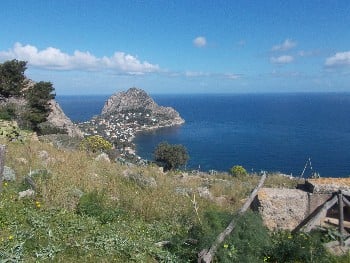A trip into an archeological area.
The first thing a tourist can admire is the beautiful landscape, it seems an open space museum: the ruins of Solunto’s city. The site is located on Catalfano’s mountain nearby Palermo. There’s a spectacular view surranded by lights and colors that can touch your soul: from one side you can see the excavation of the Phoenician- Hellenistic- Roman city, from the other side our “nostrum” wonderful sea. It was founded by Carthaginians in the IV century B.C. upon ruins of an ancient Phoenician city, rivaled for a long time with Motya and Palermo, who were Phoenicians cities too. Then it was submitted by Greeks and later it have been conquered by Romans after the first Punic war of the III century B.C. Because all these reasons its name is changed from the Phoenician Karafa ( taken from the ancient coins) to the Carthaginian Selaim (cliff), then to the greek Solos (iron rock) corresponding to the latin name of Soluntum. Walking through the “Antiquarium”, where there are different findings, you can enter the archeological area: suddenly the stones bring you back of thousands years (2400). The city was founded under direction of Ippodamo from Mileto, it’s regularly devided from different streets, around the main Agora street. Here there were nobiliar houses and the most important markets made with stones and earthware. Once you are in the right side of the archeological site you can see the hot springs, you can still admire the mosaic on the floor. The Cliff gave the possibility to collect the rain waters into big tanks located in many places of the city. Between the houses the most important is the Gimnasio house and the most beautiful is Leda’s house. The rooms of these houses are fully decorated with pompeian mosaics and paintings and some of the statues were made with marble. In the middle of one room there’s an incredible Astrolabe (ancient astronomic tool used to calculate the position of the sun, moon, stars and planets. Also it can calculate the local time just knowing the longitude; that means in the past people were aware of the roundness of the earth). The mosaic around it is dated to the II century B.C. and it may comes from Alessandria. Walking forward there’s the Agorà ( the square). A big rectangular space with bricks and maybe closed with walls (like Mileto’s market). Then you can discover 9 rectangular exedras, gifted with 2 pillars, they were used like living rooms, beside 2 shrines: one with a tank used maybe for collecting victim’s blood; the second maybe was gifted with Zeus’s statues. On the upper terrace there are findings of a Theatre. It’s similar to the Segesta’s one, with a spectacular sea view. Rebuilt I the roman period. The prickly pears delimit the left area where you can see a breathtaking view on Capo Zafferano, that stands between sky and sea, with below the little town of S. Elia and on the right side, in a bay, the ruins of the medieval castle of Solunto.



